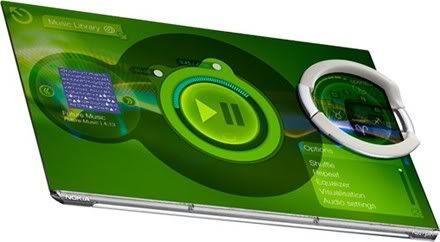The first big culture shift for many newsrooms was posting constantly throughout the day. The next big shift might be reporting live from the scene. Let's look at two notable ways for mobile journalists to get their mojo working: The iPhone vs. the Nokia N95.
The iPhone is the ultimate consumer item -- for consuming media, not for producing journalism. The Nokia N95 is more productive, but you might wish you had a personal IT staff to make the most of it.
The iPhone is beautiful, brilliant and limited. What it does, it was born to do. The Nokia does many more things, with the goal of jamming as many applications as possible into a cell phone, then polishing them until they work together surprisingly well. Nearly every difference between the two comes down to that difference in philosophy. But let's get to the journalism.
Writing and editing.
It's madness. With the iPhone, you can type but not edit. With the Nokia, you can edit but not type.
You can type just fine on the iPhone's slick little QWERTY keyboard. Typing with your thumbs is an odd idea that soon becomes natural. You just can't cut, copy and paste like computer users do every day. You can delete what you've typed by backspacing character by character, and it's not much of a stretch to think that shift and backspace could let you highlight text, and one more key on the little keyboard would let you CTRL X, CNTRL C, CNTRL V. IPhone fans are pleading for this, but here's some insight into why Apple might be stubborn about copy and paste, so far. If Apple doesn't offer it soon, Google might, through Google Docs.
With the Nokia, you can cut, copy and paste; in other words, you can revise, rewrite and edit, like a journalist would. But you're pecking on a cell phone's number pad, where every number represents at least three characters. That's a pain. And typing an actual number is even more of a pain. Maybe it's no big deal if you spent your childhood texting your BFF, but you won't write much of a story on the N95. Nokia put a lot of effort into a screen that slides out just so you can use the limited number pad.
Tip: You can order a wireless keyboard for the Nokia, even a keyboard that folds to about the size of a CD case and can fit in a coat pocket. Be sure to get one that specifically works with the Nokia N95. There are compatibility issues. It turns out that the one keyboard that is easiest to use and most compatible with this Nokia is made by Apple. The Apple Wireless Keyboard is sturdy and light, but it doesn't fold. It won't fit in a coat pocket, but you can toss it in your bag. It'll boost the expense by about $70, but you can tell yourself, or your boss, that it's a great deal for a laptop. Advantage: iPhone, but the Nokia with optional keyboard comes close.
Photos and video.
You can take decent photos with the iPhone's 2 megapixel camera, decent for a cellphone, although they tend to have a melancholy hue. The iPhone is hard to handle as a camera, especially with one hand, since the camera is in one corner of the slab and the button is a spot on the screen on the other side, with no feel to it. You can't take videos.
The Nokia has two still cameras: a 5 megapixel on the backside that takes excellent photos and a lower resolution on the phone side for taking photos of yourself. The camera is slow to open, with lots of shutter lag. To capture the decisive moment, you'd better be ready ahead of time and pointed right at it.
The Nokia's video camera has settings that include low-quality e-mail, high-quality e-mail, low-quality TV and high-quality TV. A high-quality TV video from your phone might truly put you in the realm of multimedia mobile journalist. You'll want a tripod, though, if you want to get beyond shaky-cameraphone journalism, not matter how good the image is. The Nokia also has an audio recorder, an excellent thing for journalists. The iPhone doesn't. Advantage: Nokia.
Tip: You can make a tripod for the Nokia out of a plastic bottle and an old earphone jack. Drill a hole in the bottle cap, push the jack through for a tight fit, and enjoy.
E-mail and messaging.
E-mail is a breeze with the iPhone, and it's easy to set up your home accounts. But beware: If your home account is with a cable company's Internet, such as Time Warner's Roadrunner, you can receive e-mail on your iPhone through that account, but you can't send it. The cable company thinks an e-mail message from your account that doesn't come through its modem must be spam. You can get around this by getting a gmail account at Google. Text messaging is also a breeze. E-mail and messaging are easy enough on the Nokia, but with a few more layers and steps to go through. Remember, typing on the Nokia is a burden. And the iPhone doesn't do attachments. Advantage: iPhone for ease, Nokia for attachments.
Synching and swimming.
Synching a phone with a computer used to be like wrestling a pig, and all you got out of it were updated contacts and appointments ... none of the big stuff like moving actual documents. It's easier these days. The iPhone syncs seamlessly through iTunes: Videos, photos, bookmarks and contacts, until it seems like a little extension of your computer. But it still doesn't sync documents, not even notes. The Nokia syncs just about any file you can put in a computer. You can type a document on your computer, sync it to the phone, and send it as an e-mail. Or vice versa. You'll be poking around in the manual a little to set up the Bluetooth wireless connection, then you'll realize it's easier than it looks. Advantage: iPhone for ease, Nokia for productivity.
Web browsing.
The Nokia is good at Web browsing, for a cell phone. The Web pages are full, colorful and sharp. But you're pecking on the phone keys to move a small arrow around the page. The iPhone is in a league of its own. Touch, sweep, pinch and spread is another odd idea that's simply natural. The only downside is that some pages are so crowded with links that there's not much space to pinch within. You'll find it easy to update blogs, fill out forms and do lots of Web-based work on the iPhone. You won't be able to upload a photo to your blog the way you would with a computer, however. Advantage: iPhone, no contest.
Jails and cells.
One of the biggest differences is that the iPhone comes locked to one carrier, AT&T, and uses the Edge network, which tends to be slower than the newer 3G, which is available in some areas. Not a big deal if you mostly use wi-fi anyway. The Nokia N95 comes unlocked, which means you can buy a SIM card and use the phone with the carrier you choose. That's especially good if you're going to travel in Europe. Rogue developers have been "jailbreaking" iPhones to unlock them, but each new upgrade from Apple could wipe out their work. If you want Internet and data on your Nokia, which is probably a big reason you're getting a phone like this, you're back down to one or two carriers anyway: AT&T and T-Mobile around here. Advantage: Nokia.
Questions to ask.
1. What kind of journalism can you do with an iPhone? A lot of writing, but not much editing. A lot by e-mail, and even more by Web. Photos, but no video.
Tip: Sign up for an account at Flickr.com, the photo-sharing site, then e-mail your photos to Flickr, which can automatically post the photo to your blog.
2. How much journalism can you do with the Nokia N95? A lot. You're basically carrying around everything you need to do on-the-scene multimedia reporting, up to mid-level quality, depending on your skills. You'll be pushing the envelope of, perhaps breaking out of, cameraphone journalism. The staff will probably have videographers with high-end equipment doing excellent work. But it'll have reporters in more places. If they already have laptops and digital cameras, how often will they be in a courtroom or on the sidelines where they could use a device that fits in the pocket? If you're outfitting a reporter from scratch, or yourself, maybe it makes more sense to start here, with the gear to be ready for anything. Call it pocket journalism, if you want.
3. How can you get the company to buy you a Nokia N95? Just keeping telling your boss it's a great deal on a laptop ... and a digital camera ... and a video camera ... and an audio recorder ...
Tip: The Nokia comes with video-out cables that hook up easily to a TV set. Now you've got a monitor to go with your keyboard, with the phone as your computer. This comes close to something I've often dreamt of: A little brain you can carry around and plug into whatever interface is right for the moment. Strange dream, I know, but here it is.
Remorse factor.
Sometimes it's nerve-wracking to be an early adopter of expensive gadgets. What are the chances the price will drop the week after you buy one? Or a new version will come out with more features? Or a cheaper model will add features? Let's look ahead.
The iPhone is a fledgling device that's slowly adding features. It already surprised its owners with a price drop. Some additions, like cut-and-paste, are likely to be software updates that work for current owners. The next new models are likely to be 3G-compatible and/or 16 gigabyte models, leaving you behind. The iPod Touch is quickly adding iPhone's features for less, but it certainly can't be called a journalism-producing device.
We used the Nokia N95-2 (8GB), while the Nokia N95-3 * has been around for a few months. The big issue is 3G-compatibility. If you use a lot of wi-fi anyway, the cellphone signal's speed won't be such a big deal. If you expect to send a lot of news through the carrier's network, you'll want to angle for the higher-speed 3G if you can get it. Beyond wi-fi is WiMax, someday. Remember, "Speed's just a question of money. How fast can you go?"
One to watch: The Nokia N82 is the newest version of the N95, with a nonsliding, rotating, iPhone-like (but smaller) screen and a xenon flash to take better night photos. It's what Reuters is giving its mobile journalists. You can bet that whatever you get, somebody in Europe or Japan will a newer version and a faster signal.
Other options: You could outfit a laptop with a wireless broadband card, if you're confident of the service and luggability is not an issue. But you'll still need a digital camera. Or maybe your boss will buy you a StarCar.
* N95-3? What's with all the numbers? We're buying a phone, not a BMW. What was wrong with the three versions of the other 94 models? One more reason to appreciate the consumer-friendly iPhone.
This post cost a lot of money. I hope you found it valuable. If you have any questions, suggestions or corrections, e-mail bcubbison@syracuse.com.

